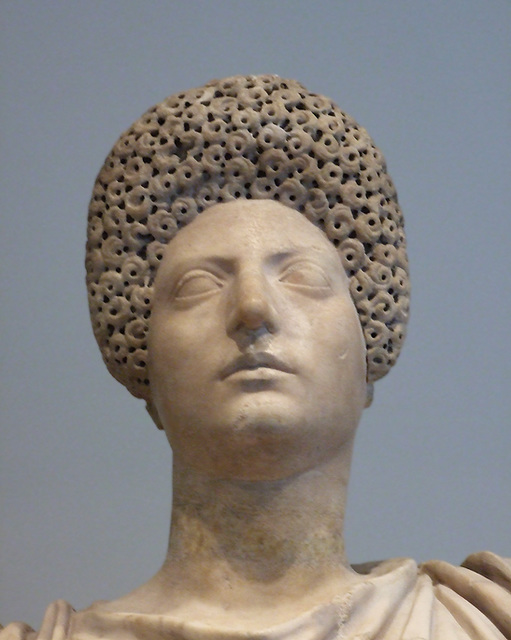Location
Lat, Lng: 40.779509, -73.963458
You can copy the above to your favourite mapping app.
Address: Sigmund Pretzel Cart
You can copy the above to your favourite mapping app.
Address: Sigmund Pretzel Cart
See also...
Keywords
Authorizations, license
-
Visible by: Everyone -
All rights reserved
-
398 visits
Detail of the Marble Statue of Tyche-Fortuna Restored with the Portrait Head of a Woman in the Metropolitan Museum of Art, September 2009


Title: Marble statue of Tyche-Fortuna restored with the portrait head of a woman
Medium; Technique: Marble
Culture: Roman
Period: Imperial, late Flavian or early Trajanic
Date: 1st or 2nd century A.D.
Credit Line: Fletcher Fund, 1961
Accession Number: 61.82.2
On View
Text from: www.metmuseum.org/Works_of_Art/collection_database/greek_...
and
During the eighteenth century newly excavated ancient sculpture was cleaned and restored in workshops in Rome before being sold to members of the European nobility. Several unrelated ancient works were often combined in order to make a complete statue. Here, the portrait head of a Roman woman, her hair arranged in a style fashionable in the late 1st century AD, was placed on a damaged statue of a goddess known as Tyche in Greek and as Fortuna in Latin. She is recognizable by her attributes—a cornucopia and a ship’s rudder—which symbolize the prosperity she could bestow and her power to steer and control events. The statue was acquired in the late eighteenth century by the British statesman William Fitzmaurice, second earl of Shelburne, who, as Home Secretary, oversaw the end of the American War of Independence and the recognition of the United States. He assembled a distinguished collection of antiquities at Lansdowne House in London, where this statue of Tyche-Fortuna once stood in a niche in the dining room. The room, designed by Robert Adam, is now installed in the Museum along with other period rooms from England.
Text from the Metropolitan Museum of Art label.
Medium; Technique: Marble
Culture: Roman
Period: Imperial, late Flavian or early Trajanic
Date: 1st or 2nd century A.D.
Credit Line: Fletcher Fund, 1961
Accession Number: 61.82.2
On View
Text from: www.metmuseum.org/Works_of_Art/collection_database/greek_...
and
During the eighteenth century newly excavated ancient sculpture was cleaned and restored in workshops in Rome before being sold to members of the European nobility. Several unrelated ancient works were often combined in order to make a complete statue. Here, the portrait head of a Roman woman, her hair arranged in a style fashionable in the late 1st century AD, was placed on a damaged statue of a goddess known as Tyche in Greek and as Fortuna in Latin. She is recognizable by her attributes—a cornucopia and a ship’s rudder—which symbolize the prosperity she could bestow and her power to steer and control events. The statue was acquired in the late eighteenth century by the British statesman William Fitzmaurice, second earl of Shelburne, who, as Home Secretary, oversaw the end of the American War of Independence and the recognition of the United States. He assembled a distinguished collection of antiquities at Lansdowne House in London, where this statue of Tyche-Fortuna once stood in a niche in the dining room. The room, designed by Robert Adam, is now installed in the Museum along with other period rooms from England.
Text from the Metropolitan Museum of Art label.
- Keyboard shortcuts:
Jump to top
RSS feed- Latest comments - Subscribe to the comment feeds of this photo
- ipernity © 2007-2025
- Help & Contact
|
Club news
|
About ipernity
|
History |
ipernity Club & Prices |
Guide of good conduct
Donate | Group guidelines | Privacy policy | Terms of use | Statutes | In memoria -
Facebook
Twitter











Sign-in to write a comment.